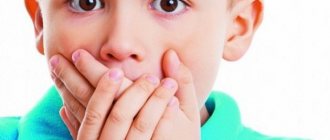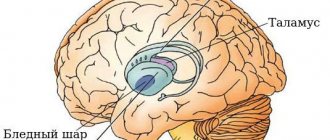general information
With dysarthria, the functioning of the motor nerves is disrupted. Because of this, the child’s speech is difficult to switch between sounds, it is difficult to understand and sounds blurry. There may be problems with breathing and intonation.
The defect is always based on problems with the nervous system. Most often they occur as a result of unfavorable pregnancy and childbirth. A slight lack of oxygen negatively affects brain function.
In the first year of life, the child’s body is very sensitive to various types of infections and injuries. Any such exposure can lead to the death of nerve cells and the development of pathologies.
Most often, dysarthria accompanies cerebral palsy. But its mild forms are also observed in preschoolers without these pathologies. Manifestations of the defect can have varying degrees of severity.
The peculiarity of this disorder is that the preschooler does not feel the muscles of the oral cavity - neither tension nor relaxation. This is what makes it difficult for organs to switch from one sound to another sound.
Difficulties may arise in forming a connection between the movements of the organs of articulation and the heard sound. Children have motor skills problems and are often clumsy and awkward.
Involuntary movements due to dysarthria
With dysarthria, a child often experiences involuntary movements, which are of three types:
- Hyperkinesis is movements observed at rest and intensified when performing voluntary movements. They are associated with damage to the subcortical parts of the brain and appear against the background of changes in muscle tone in the form of individual, chaotic, non-rhythmic movements.
- Tremors are rhythmic small twitches that are observed against the background of low muscle tone, both at rest and during voluntary movements.
- Synkinesias are friendly involuntary movements that do not contribute to the performance of a motor task and occur only when performing voluntary movements.
Physical manifestations
Many researchers have studied children with dysarthria. This made it possible to highlight an important feature: this category is not homogeneous.
This means that any form, even the most severe, can be observed in children with normal intelligence, while mild forms appear in preschoolers with intellectual disabilities.
Clinical and psychological characteristics of children with dysarthria allow us to get a complete picture of the individual characteristics and needs of the group. Only on its basis can a correct work plan be drawn up.
Thanks to the research of specialists, it was possible to find out that there is no relationship between the severity of the defect and the severity of the pathology.
Most often, such a disorder is observed in children:
- normal development;
- with mental retardation (MDD);
- with mental retardation;
- with hydrocephalus.
In recent years, another category of children has been identified - with minimal brain dysfunction (MCD). It is characterized not only by problems with speech, but also by disorders of higher mental functions (HMF).
Non-critical delays may be observed in physical development. The child will crawl, sit down, and stand up a little later. The lag will not be serious. There will be some difficulty manipulating objects and making fine finger movements.
In most cases, there are no serious problems with gross and fine motor skills. There is some lack of coordination of movements and awkwardness in performing tasks. It is difficult to master self-service skills. It is difficult to perform hygienic actions. For example, taking water into your mouth and rinsing is not so easy.
In preschool age, they have difficulty fastening buttons, tying shoelaces, etc. In outdoor games, they are inferior to their peers in dexterity and reaction speed.
Degrees of disorder
Dysarthric disorder is not limited to speech defects. This includes all disorders that are in one way or another associated with pathological innervation or with inadequate functioning of improperly innervated organs. Thus, due to hypotonia or hypertonicity of the tongue, as well as paresis of the soft palate, difficulties appear in the act of swallowing and chewing. Ptyalism is observed - increased salivation. Facial expressions suffer due to a disorder of the innervation of the facial muscles. The inability to move the eyebrows, smile, puff out the cheeks, the face takes on the appearance of a mask.
However, it cannot be said that one patient has all the pathological characteristics. The disease manifests itself depending on the degree of development of the disorder.
A mild degree of dysarthria is accompanied by a reduction in the activity of the articulatory side of speech due to slow movements of the tongue and lips. The speech of such patients is slowed down and lacks forceful expression. Sounds are blurred during pronunciation. It is difficult to pronounce hissing words, voiced consonants do not sound loud enough. The sound of soft consonants is disrupted, as this requires the active participation of the back of the tongue and the soft palate. Swallowing is practically unimpaired.
With an average degree, a significant modification of speech is already observed. She becomes inarticulate and very quiet. Even defects in the pronunciation of consonants appear. Voiced consonants are replaced by voiceless ones. The endings are swallowed. The voice becomes nasal and there is increased nasal exhalation. Characterized by chewing and swallowing disorders. Facial expressions suffer.
Severe severity is characterized by deep lesions of the speech-motor system. As a result, the tongue and lips of such patients are almost completely immobilized, and the face acquires mask-like features. The mouth is always half open due to drooping of the lower jaw. All this makes speech production very difficult, resulting in anarthria - the inability to speak. A person can only make individual sounds. Chewing and swallowing are inaccessible to him.
Features of psychology
The psychological and pedagogical characteristics of children with dysarthria make it possible to correctly organize the work of specialists. In a preschool educational institution (preschool educational institution), not only a speech therapist, but also a psychologist will work with the child.
The category is heterogeneous in its manifestations. Some have poor adaptation to changing environmental conditions. They will be afraid of everything new and refuse to get used to it. When faced with difficulties, they prefer to avoid them rather than solve them.
Another group will differ radically in psychological manifestations. Their nervous system quickly depletes, they are sensitive to the weather and have a high level of excitability. They are characterized by poor appetite and sleep.
Often in childhood, dysarthria is accompanied by anxiety. A child rarely finds the reason for his failure. The game is primitive and stereotypical.
Psychologically, problems arise in the area of motivation. This is especially evident at school age. In some situations, protest is expressed by hysterics.
Children may refuse to attend lessons, complete assignments at home, ignore the teacher’s demands, etc. All this is associated with an acute experience of a defect and a feeling of personal failure.
Features of a child with erased dysarthria
Erased dysarthria occurs very often in speech therapy practice. The main complaints with erased dysarthria: slurred, inexpressive speech, poor diction, distortion and replacement of sounds in words with complex syllable structure, etc.
Erased dysarthria is a speech pathology that manifests itself in disorders of the phonetic and prosodic components of the speech functional system and arises as a result of unexpressed microorganic damage to the brain (L.V. Lopatina).
A survey of children in mass kindergartens showed that in senior and preparatory school groups from 40 to 60% of children have deviations in speech development. Among the most common disorders: dyslalia , rhinophonia, phonetic-phonemic underdevelopment, erased dysarthria .
In groups for children with general speech underdevelopment, up to 50% of children, and in groups with phonetic-phonemic underdevelopment, up to 35% of children have erased dysarthria. Children with severe dysarthria need long-term, systematic individual speech therapy assistance. Speech therapists of specialized groups plan speech therapy work as follows: in frontal, subgroup classes with all children they study program material aimed at eliminating general speech underdevelopment, and in individual classes they correct the pronunciation side of speech and prosody, i.e. elimination of symptoms of erased dysarthria.
The erased form of dysarthria is most often diagnosed after five years. All children whose symptoms correspond to erased dysarthria are sent for consultation to a neurologist to clarify or confirm the diagnosis and to prescribe adequate treatment, because in case of erased dysarthria, the method of correctional work should be comprehensive and include: - medical intervention; — psychological and pedagogical assistance; - speech therapy work.
For early detection of erased dysarthria and proper organization of complex effects, it is necessary to know the symptoms that characterize these disorders. The examination of the child begins with a conversation with the mother and study of the child’s outpatient development chart. Analysis of anamnestic information shows that there are: deviations in intrauterine development (toxicosis, hypertension, nephropathy, etc.); asphyxia of newborns; rapid or prolonged labor. According to the mother, “the child did not cry right away; the child was brought in to be fed later than everyone else.” In the first year of life, many were observed by a neurologist and prescribed medication and massage. The diagnosis for up to a year was “PEP” (perinatal encephalopathy). The development of a child after one year, as a rule, is successful for everyone, the neurologist no longer observes these children, and the child is considered healthy. When examined in a clinic by a speech therapist, children aged 5-6 years with erased dysarthria reveal the following symptoms:
GENERAL MOTOR SKILLS. Children with erased dysarthria are motorically awkward, the range of active movements is limited, and the muscles quickly tire during functional loads. They stand unsteadily on one leg, cannot jump on one leg, walk along a “bridge,” etc. They imitate movements poorly: how a soldier walks, how a bird flies, how bread is cut, etc. Motor incompetence is especially noticeable in physical education and music classes, where children lag behind in tempo, rhythm of movements, as well as in switching movements.
FINE MOTOR SKILLS OF HAND. Children with erased dysarthria late and have difficulty mastering self-care skills: they cannot button a button, untie a scarf, etc. During drawing classes, they don’t hold a pencil well and their hands are tense. Many people don't like to draw. Motor clumsiness of the hands is especially noticeable during applique classes and with plasticine. In works on appliqué, difficulties in the spatial arrangement of elements can also be traced. Violation of fine differentiated movements of the hands is manifested when performing sample tests of finger gymnastics. Children find it difficult or simply cannot perform an imitation movement without outside help, for example, “lock” - put their hands together, intertwining their fingers; “rings” - alternately connect the index, middle, ring and little fingers with the thumb, and other finger gymnastics exercises.
During origami classes they experience great difficulties and cannot perform the simplest movements, because... both spatial orientation and subtle differentiated hand movements are required. According to mothers, many children under 5-6 years old are not interested in playing with construction sets, do not know how to play with small toys, and do not assemble puzzles.
School-age children in the first grade experience difficulties in mastering graphic skills (some experience “mirror writing”; substitution of letters “d” - “b”, vowels, word endings; poor handwriting; slow pace of writing, etc.).
FEATURES OF THE ARTICULATING APPARATUS. In children with erased dysarthria, pathological features in the articulatory apparatus are revealed. Pareticity of the muscles of the organs of articulation is manifested in the following: the face is hypomimic, the facial muscles are flaccid upon palpation; Many children do not maintain the closed mouth pose, because the lower jaw is not fixed in an elevated state due to laxity of the masticatory muscles; lips are flaccid, their corners are drooping; During speech, the lips remain flaccid and the necessary labialization of sounds is not produced, which worsens the prosodic aspect of speech. The tongue with paretic symptoms is thin, located at the bottom of the mouth, flaccid, the tip of the tongue is inactive. With functional loads (articulation exercises), muscle weakness increases. Spasticity of the muscles of the organs of articulation is manifested in the following: the face is amicable, the facial muscles are hard and tense on palpation. The lips of such a child are constantly in a half-smile: the upper lip is pressed against the gums. During speech, the lips do not take part in the articulation of sounds. Many children who have similar symptoms do not know how to perform the “tube” articulation exercise, i.e. pull the lips forward, etc. With a spastic symptom, the tongue is often changed in shape: thick, without a pronounced tip, inactive.
Hyperkinesis with erased dysarthria manifests itself in the form of trembling, tremor of the tongue and vocal cords. Tremor of the tongue appears during functional tests and loads. For example, when asked to support a wide tongue on the lower lip with a count of 5-10, the tongue cannot maintain a state of rest, trembling and slight cyanosis appear (i.e., blue tip of the tongue), and in some cases the tongue is extremely restless (waves roll through the tongue in longitudinal or transverse direction). In this case, the child cannot keep his tongue out of the mouth. Hyperkinesis of the tongue is often combined with increased muscle tone of the articulatory apparatus.
Apraxia with erased dysarthria is simultaneously detected in the inability to perform any voluntary movements with the hands and organs of articulation. In the articulatory apparatus, apraxia manifests itself in the inability to perform certain movements or when switching from one movement to another. Kinetic apraxia can be observed when the child cannot smoothly transition from one movement to another. Other children experience kinesthetic apraxia, when the child makes chaotic movements, “groping” for the desired articulatory position. Deviation, i.e. deviation of the tongue from the midline, also manifests itself during articulation tests and during functional loads. Deviation of the tongue is combined with asymmetry of the lips when smiling with a smoothness of the nasolabial fold.
Hypersalivation (increased salivation) is detected only during speech. Children cannot cope with salivation, do not swallow saliva, and the pronunciation side of speech and prosody suffer.
When examining the motor function of the articulatory apparatus in children with erased dysarthria, the ability to perform all articulation tests is noted, i.e. Children, according to instructions, perform all articulatory movements - for example, puff out their cheeks, click their tongue, smile, stretch out their lips, etc. When analyzing the quality of performing these movements, one can note: blurriness, unclear articulation, weakness of muscle tension, arrhythmia, decreased range of movements, short duration of holding a certain pose, decreased range of movements, rapid muscle fatigue, etc. Thus, under functional loads, the quality of articulatory movements sharply falls. During speech, this leads to distortion of sounds, their mixing and deterioration in the overall prosodic aspect of speech.
SOUND PRONUNCIATION. When first meeting a child, his sound pronunciation is assessed as complex dyslalia or simple dyslalia. When examining sound pronunciation, the following are revealed: confusion, distortion of sounds, replacement and absence of sounds, i.e. the same options as for dyslalia. But, unlike dyslalia, speech with erased dysarthria also has disturbances on the prosodic side. Impaired pronunciation and prosody affect speech intelligibility, intelligibility, and expressiveness. Some children go to the clinic after classes with a speech therapist. Parents ask why the sounds that the speech therapist provided are not used in the child’s speech. The examination reveals that many children who distort, omit, mix or replace sounds can pronounce these same sounds correctly in isolation. Thus, sounds in erased dysarthria are produced in the same ways as in dyslalia, but for a long time they are not automated and are not introduced into speech. The most common violation is a defect in the pronunciation of whistling and hissing sounds. Children with erased dysarthria distort and mix not only articulatory complex sounds that are close in place and method of formation, but also acoustically opposed ones. Quite often, interdental pronunciation and lateral overtones are noted. Children have difficulty pronouncing words with a complex syllabic structure; they simplify the sound content by omitting some sounds when consonants are combined.
PROSODICA. The intonation-expressive coloring of the speech of children with erased dysarthria is sharply reduced. The voice, vocal modulations in pitch and strength suffer, speech exhalation is weakened. The timbre of speech is disrupted and sometimes a nasal tone appears. The pace of speech is often accelerated. When reciting a poem, the child’s speech is monotonous, gradually becomes less intelligible, and the voice fades away. The children's voice during speech is quiet, modulation in pitch and voice strength is not possible (the child cannot change the pitch of the voice by imitation, imitating the voices of animals: cows, dogs, etc.). In some children, speech exhalation is shortened, and they speak while inhaling. In this case, speech becomes choked. Quite often, children are identified (with good self-control) in whom, during a speech examination, deviations in sound pronunciation do not appear, because They pronounce the words in a chant, i.e. by syllables, and only violation of prosody comes first.
GENERAL SPEECH DEVELOPMENT. Children with erased dysarthria can be divided into three groups. First group. Children who have impaired sound pronunciation and prosody. This group is very similar to children with dyslalia. Often, speech therapists treat them as dyslastic, and only in the process of speech therapy work, when there is no positive dynamics in the automation of sounds, does a suspicion arise that this is erased dysarthria. Most often, this is confirmed during an in-depth examination and after consultation with a neurologist. These children have a good level of speech development, but many of them have difficulty learning, distinguishing and reproducing prepositions. Children confuse complex prepositions and have problems distinguishing and using prefixed verbs. At the same time, they speak coherent speech and have a rich vocabulary, but may have difficulty pronouncing words with a complex syllabic structure (for example, frying pan, tablecloth, button, snowman, etc.). In addition, many children experience difficulties with spatial orientation (body diagram, concepts of “below-above,” etc.).
Second group. These are children in whom a violation of sound pronunciation and the prosodic side of speech is combined with the incomplete process of forming phonemic hearing. In this case, children encounter isolated lexical and grammatical errors in their speech. Children make mistakes in special tasks when listening and repeating syllables and words with oppositional sounds - for example, when asked to show the desired picture (mouse-bear, fishing rod-duck, scythe-goat, etc.).
Thus, in children, the auditory and pronunciation differentiation of sounds is unformed. Children's vocabulary lags behind the age norm. Many people experience difficulties in word formation, make mistakes in agreeing a noun with a numeral, etc. Sound pronunciation defects are persistent and are regarded as complex, polymorphic disorders. This group of children with phonetic-phonemic underdevelopment (FFN) and erased dysarthria should be referred by the speech therapist of the clinic to the MPC (medical-pedagogical commission), to a specialized kindergarten (to the FFN group).
Third group. These are children who have a persistent polymorphic disorder of sound pronunciation and a lack of prosodic aspect of speech combined with underdevelopment of phonemic hearing. As a result, the examination reveals a poor vocabulary, pronounced errors in grammatical structure, the impossibility of a coherent statement, and significant difficulties in mastering words of different syllabic structures.
All children in this group demonstrate undeveloped auditory and pronunciation differentiation. Ignoring prepositions in speech is indicative. These children with erased dysarthria and general speech underdevelopment (GSD) should be sent to MPC (in specialized kindergarten groups) to GSD groups. Thus, children with erased dysarthria are a heterogeneous group. Depending on the level of development of linguistic means, children are sent to specialized groups: - with phonetic disorders; - with phonetic-phonemic underdevelopment; - with general speech underdevelopment .
(according to E. F. Arkhipova)
Do you need a speech therapist in Sviblovo? Sign up for a consultation by phone or through the feedback form in the “Contacts” section.
Pedagogical characteristics
Speech therapy includes not only disorders of oral speech, but also written speech. If help is untimely or if the defect is severe, there will be problems with writing and reading.
In preschool age, there is a late development of interest in drawing. Children have difficulty mastering pencils, pens, and scissors. They do not regulate the pressure on the writing instrument; it is difficult to shade the area.
In pedagogical terms, physical education and music are the hardest for them. This is due to the underdevelopment of the motor sphere. Jumping on one leg, changing poses, or moving to music is not possible.
Due to problems with memory and attention, they study poorly. In the absence of understanding on the part of the teacher, children develop negativism and develop psychological problems.
In kindergarten and in class they are often fussy, disobedient and irritable. They can be rude to elders.
In the absence of a primary intellectual disability, dysarthric people are able to assimilate standard educational programs. They can be inquisitive, but because they get tired quickly, they have trouble absorbing large amounts of information.
Sometimes there may be problems with a certain type of perception, for example, visual. In this case, the child has difficulty distinguishing between similar shades or comparing two objects by size.
May not listen to the teacher's task, interrupt him, shout and be easily distracted. It is impossible to force him to do anything for a long time. Any irritant quickly switches his attention to something else. Therefore, there should be no bright pictures, toys or other equipment in the study room. They will only be a distraction.
During school time, it is advisable to place such children on desks 1-2. This will allow your memory to work well and absorb the material.
Movement perception in children
With dysarthria, disturbances in the sensation or perception of movements are observed, i.e. speech kinesthesia (for example, when a child does not understand where he is moving his hand). Voice disturbances are also characteristic (usually dull, unmodulated), the pitch of the voice changes, there is no ability to voluntarily regulate the strength of the voice, and sometimes spasmodic dysphonia (tonic vocal spasm) is observed.
The difference is paresis or paralysis of the muscles of the soft palate. This results in a "nasal voice". In addition, speech breathing disorder is characteristic: speech exhalation is shortened, so at the moment of speech there is a feeling of lack of air (convulsive breaths, gasping for air), which leads to impaired speech fluency. Rhythmic (soba'ka - soba'ki) and dynamic (Lesni'k - foresters') stresses are disrupted - this grossly distorts speech.
Dysarthria is characterized by a violation of coordination in the work of the muscles of the articulatory apparatus and voice formation.





